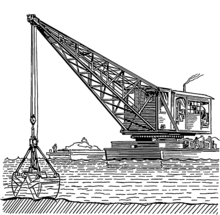
Back Baggerwerk Afrikaans تجريف Arabic Dragáu AST तरछी Bihari ড্রেজিং Bengali/Bangla Dragatge Catalan Opmudring Danish Baggerschiff German Dragado Esperanto Dragado Spanish

Dredging is the excavation of material from a water environment. Possible reasons for dredging include improving existing water features; reshaping land and water features to alter drainage, navigability, and commercial use; constructing dams, dikes, and other controls for streams and shorelines; and recovering valuable mineral deposits or marine life having commercial value. In all but a few situations the excavation is undertaken by a specialist floating plant, known as a dredger.
Usually the main objectives of dredging is to recover material of value, or to create a greater depth of water.[1] Dredging systems can either be shore-based, brought to a location based on barges, or built into purpose-built vessels.
Dredging can have environmental impacts: it canc disturb marine sediments, creating dredge plumes which can lead to both short- and long-term water pollution, damage or destroy seabed ecosystems, and release legacy human-sourced toxins captured in the sediment. These environmental impacts can reduce marine wildlife populations, contaminate sources of drinking water, and interrupt economic activities such as fishing.
- ^ "EuDA - About dredging - Dredging". www.european-dredging.eu. Retrieved 3 July 2018.